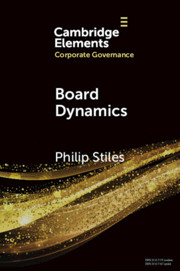Element contents
Board Dynamics
Published online by Cambridge University Press: 18 June 2021
Summary
Keywords
- Type
- Element
- Information
- Series: Elements in Corporate GovernanceOnline ISBN: 9781108974875Publisher: Cambridge University PressPrint publication: 12 August 2021
References
- 4
- Cited by



